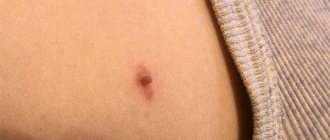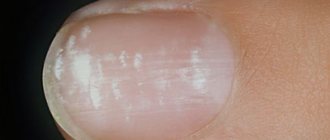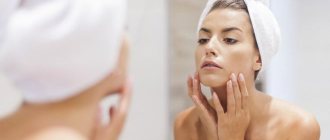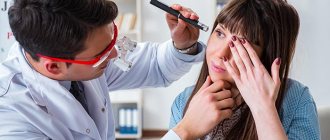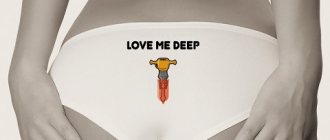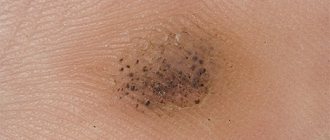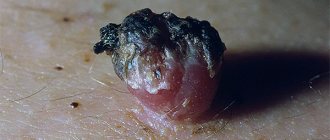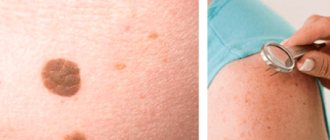Rosacea
Experts are accustomed to using the term rosacea to understand a certain clinical picture: erythema, dilated vessels, and later papulopustular rashes. However, rosacea has several degrees of development and subtypes.
Degree of development of rosacea
- Episodic erythema (rosacea—diathesis);
- I degree - ETR (persistent erythema and single telangiectasia);
- II degree - papulopustular (persistent erythema, numerous telangiectasia, papules, pustules);
- III degree - pustular nodular (persistent erythema, an abundance of telangiectasias, papules, pustules, inflammatory edematous nodes).
There are currently 4 subtypes of rosacea :
- ETR is characterized by persistent erythema of the central area of the face, occurring before or simultaneously with papulopustules (subtype II), telangiectasia, and is accompanied by a burning sensation and tingling sensation.
- PPR - persistent erythema, transient papules and pustules.
- Phymatous rosacea is a thickening of the skin with an increase in the pathologically altered area.
- Ophthalmic rosacea - dryness of the mucous membrane of the eyes, lacrimation, burning, swelling of the eyelids, recurrent inflammation and decreased visual acuity due to damage to the cornea.
Let's move on to diseases that require differential diagnosis with rosacea.
Causes of red dots near the eyes
If the patient does not have any systemic disease, red dots around the eyes may only indicate broken capillaries. A person may not notice how he hurt himself or was bitten by an insect. If such a phenomenon occurred once and quickly disappeared, there is no need to worry. It is necessary to consult a doctor if you suspect a disease or recurrent hemorrhage.
Petechiae can form due to the following reasons:
- severe prolonged sneezing, coughing, which temporarily increases blood pressure;
- constant increase in blood pressure, hypertensive crises;
- increased intracranial pressure;
- weakness of the vascular walls;
- insufficient intake of nutrients from food or medications, which lead to the development of vitamin deficiency;
- pathologies of the renal system;
- malignant neoplasms of blood, red bone marrow;
- skin diseases (dermatitis, eczema);
- allergy;
- lack of oxygen supply inside the body, which leads to chronic hypoxia and damage to capillaries;
- human exposure to temporary unfavorable environmental factors (changes in pressure, exposure to bright sunlight, sudden temperature changes, strong wind);
- nervous overstrain, exhaustion, severe depression.
It is also possible that petechiae may occur due to improper use of medications. For example, during the use of anticoagulants, the blood thins, which can leak outside the vessels.
Seborrheic dermatitis
Seborrheic dermatitis is a chronic inflammatory disease associated with a violation of the amount and composition of sebum and a disturbance of the skin microbiota.
Clinical manifestations : hyperkeratosis, peeling, seborrhea, inflammation and itching.
Localization : areas with the largest number of sebaceous glands, including the T-zone of the face, as well as the scalp, upper third of the back and chest area, ears.
The common feature is centrofascial erythema, the distinctive features are: with rosacea – papules and telangiectasia, with seborrheic dermatitis – the formation of scales and peeling, which are not characteristic of rosacea.
Folk remedies
In the fight for beauty, all means are good. In addition, there are a number of products that can improve the condition of the skin that are always at hand. One way that always works is masks. They make them from literally everything.
1. Potatoes. For masks, it is rubbed on a fine grater and the resulting paste is applied to the eye area using cotton swabs for 2 or 3 minutes. The healing properties of potatoes have not yet been fully studied, but the fact that it has a beneficial effect on the skin is undeniable. 2. Dill seeds. For the mask, these seeds are poured into a small fabric bag and placed in fairly hot water. Take out the bag after a few minutes, squeeze it out and apply it to your eyes for 5 minutes. 3. Herbs. Decoctions of cornflower and string are considered especially effective.
Acne vulgaris (acne)
Acne vulgaris usually occurs between the ages of 14 and 25, while rosacea occurs between 30 and 50 years. It is also necessary to carry out a differential diagnosis with late acne .
Common manifestations with late acne
Appearance after 40 years
Papulopustular skin rashes
Overproduction of sebum – oily skin
Possibly - prolonged exposure to the sun - a common “trigger”
Differential diagnosis
Criteria not typical for acne are diagnostic for rosacea:
Centrofascial erythema is redness of the central part of the face, which may be accompanied by subjective sensations of itching, burning or tingling. A must-have for rosacea!
Outbreaks of erythema - occur when nerve endings are irritated by provoking factors: stress, heat exposure, drinking hot and alcoholic drinks, etc.
Couperosis – appearance on the face, because the disease affects the vascular bed.
No comedones!
Anamnesis
An important part of any consultation. If the rash was present at a young age, the development of late acne is most likely.
Causes of age spots and dark circles under the eyes
There are 5 main causes of dark circles and age spots on the skin under the eyes , each of which requires its own set of measures to eliminate it.
Constitutional feature of the skin
Pigment spots often occur in those with ethnically dark skin.
Recommended : avoid direct sunlight, thinning skin and/or irritating cosmetics. There is a high risk of post-inflammatory pigmentation of the skin around the eyes.
Inflammatory skin diseases
This is a variant of post-inflammatory skin pigmentation, for example after atopic or contact dermatitis.
Recommended : hypoallergenic products for the skin around the eyes, specially developed taking into account skin sensitivity.
DermaQuest CBD Revitalizing Eye Cream - Hydrates, restores and rejuvenates the delicate and irritated skin around the eyes!
• Contains the innovative double action ingredient AquaCell :
- moisturizes the skin for 24 hours, eliminates negative symptoms of dryness and smoothes dry wrinkles;
- restores the skin’s own structures, which are responsible for filling cells with moisture – a long-term effect of compacting and hydrating the skin;
• Argan stem cells – activate the skin’s own stem cells, normalize collagen production and cell division – the skin becomes more elastic and toned;
• Additionally contains Cannabidiol - a plant extract, a “boom” of 2022 in cosmetology and medicine. Heals, restores normal structures and functions of the skin - against dryness, itching and irritation of the skin. Prevents the appearance of post-inflammatory pigment spots.
Benefits of CBD Eye Cream:
Comfort and effectiveness even for ultra-sensitive skin!
Natural, safe composition with 80% ingredients of natural origin!
Moisturizes, softens and soothes the delicate skin around the eyes!
Application:
▫ Apply daily morning and evening to clean skin
▫ For an anti-edematous effect, store the jar in the refrigerator door
Internal illnesses
Diseases that cause swelling, pigment deposition and age spots around the eyes:
- Low hemoglobin level;
- Iron-deficiency anemia;
- Kidney failure;
- Diseases of the heart or blood vessels.
Recommended : consult a doctor.
Vascular disorders in the skin around the eyes
Edema forms, plasma sweats and pigment is deposited into the surrounding tissue. Later pigment spots form.
- Visually: blueness under the eyes, age spots
- Absolutely physiological and not a pathology
Recommended: mask with makeup, use products with a vasoconstrictor effect and remove pigment from surrounding tissues.
An example of such a product is described below - this is EyeBright cream for eye care DermaQuest .
Age-related skin changes
Lack of collagen due to its destruction and insufficient synthesis leads to:
- dilation of blood vessels that become visible under the skin
- loose skin visually casts a shadow, simulating dark circles and age spots
Recommended: anti-aging products based on retinol: thickens and tightens the skin, normalizes pigment formation.
The skin around the eyes is delicate, a high percentage of retinol is not indicated for this area; it is necessary to start with low percentages (0.3 - 0.5%) and preparations containing gentle forms of retinoids, for example, retinaldehyde .
Perioral dermatitis
Synonyms: rosacea-like dermatitis, flight attendant disease - rashes around the mouth: redness, swelling and papules.
Diagnostically difficult to distinguish disease of unknown etiology. Provoking factors : the use of steroids both locally and inhaled, fluoride-containing pastes, occlusive cosmetics.
The main diagnostic differences from rosacea: bright erythema and telangiectasia are rare. Localization: nasolabial folds, perioral region, chin, lower eyelids. Women aged 20-30 years and children are affected.
Distinctive feature : rapid regression of rashes, if a trigger factor is identified.
If visual diagnosis is difficult, a histological examination is recommended.
Prevention
As a rule, treatment is not required when adequate disease prevention has been established. To prevent red spots from appearing in the eye area, it is necessary to act comprehensively: make it a rule to lead a healthy lifestyle, organize yourself proper rest, as well as sleep.
It is also necessary to strengthen the body’s immune system, for which it is worth taking the necessary vitamins and minerals. Reduce mental and visual stress, walk more often. Which will lead to the disappearance of symptoms and red spots will no longer be a serious problem for you.
What diseases can bags be a symptom of?
Note! If the bags do not go away within a week or longer, your baby may have one of the following diseases:
- stye and conjunctivitis;
- kidney diseases;
- heart failure;
- metabolic disease;
- increased intracranial pressure ;
- vegetative-vascular dystonia;
- liver dysfunction;
- diabetes.
Almost any viral pathology can also provoke the occurrence of swelling under the eyes, regardless of which organs and systems they affect.
Our advantages
"Moscow Eye Clinic" offers comprehensive diagnostics and effective treatment of eye diseases. The use of the most modern equipment and the high professional level of specialists working in the clinic eliminate the possibility of diagnostic errors.
Based on the results of the examination, each visitor will be given recommendations on choosing the most effective methods of treating the eye pathologies identified in them. By contacting the Moscow Eye Clinic, you can be sure of quick and accurate diagnosis and effective treatment.
All questions you are interested in can be asked to specialists by calling 8 (800) 777-38-81 and 8 (499) 322-36-36 or online using the appropriate form on the website.
Mironova Irina Sergeevna
Diagnostics
To determine the cause of redness under the eyes, the doctor prescribes several diagnostic tests:
- examination of the oral cavity, especially the throat and tonsils;
- measuring body temperature;
- bacterial culture to identify an infectious pathogen;
- PCR method for virus detection;
- measuring blood pressure using a tonometer;
- an allergy test to determine substances to which the patient may have a reaction;
- general clinical analysis of blood and urine, blood biochemistry;
- biopsy followed by tissue histology to determine benign or malignant formation.
After receiving data from diagnostic tests, the doctor can make a reliable diagnosis and begin therapy.
Treatment
The treatment method depends on the cause that caused the condition. The most frequently taken measures are:
- drinking plenty of warm water;
- antiviral drugs;
- antibacterial agents;
- frequent walks in the fresh air;
- physiotherapy and massage for spinal pathologies;
- surgical treatment in the presence of neoplasms;
- antihistamines for seasonal or recurrent allergies;
- creams and ointments to eliminate bruises and bruises;
- gargling with antiseptics;
- treatment of teeth and gums by a dentist;
- moderate physical activity, sports.
It is recommended to periodically consult with your doctor during treatment to completely avoid the risk of relapse of the condition.
